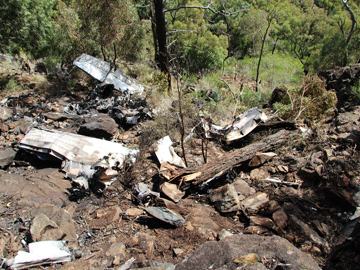
ATSB investigators have found that the fatal aircraft accident in New South Wales in 2012 was the result of a situation in which many pilots have found themselves: flying into weather conditions that cannot be dealt with. This is a frequent accident risk that the ATSB has been drawing to the attention of Australia’s general aviation community.
The accident occurred on 4 June 2012, as the pilot flew a Cessna 182Q from Walgett to Mudgee. The pilot, the only person on board, was flying under the Visual Flight Rules (VFR), a set of regulations that dictated he could fly only under favourable weather conditions. He had taken off in good weather conditions, and climbed to 5,500 ft.
From 2006 to 2010, there were 72 such occurrences reported to us, and seven of those resulted in fatal accidents. Fourteen people were killed in these accidents.
During the flight, however, the cloud base lowered, and the pilot descended the aircraft to avoid flying in Instrument Meteorological Conditions (IMC). These are conditions where a pilot has limited visibility and will need to use aircraft instruments to fly safely. The aircraft descended until it was flying about 1,000 ft above flat terrain, either close to or in the cloud. While flying at that level the aircraft crashed into a rock face in mountainous terrain near Tooraweenah, NSW. The pilot died in the accident and the aircraft was destroyed.
“The issue of pilots who fly into IMC while operating under VFR is an ongoing concern to the ATSB,” said Martin Dolan, Chief Commissioner of the ATSB. “From 2006 to 2010, there were 72 such occurrences reported to us, and seven of those resulted in fatal accidents. Fourteen people were killed in these accidents. Essentially, about one in ten VFR into IMC events results in a fatal outcome.”
The ATSB has been working to educate pilots about the dangers surrounding VFR into IMC. A booklet providing examples and advice on the subject forms part of the ATSB’s well-received Avoidable Accidents series.
The ATSB’s Avoidable Accidents booklets, including Accidents involving Visual Flight Rules pilots in Instrument Meteorological Conditions, feature case studies on regularly occurring accidents that could have been prevented with good flight management and preparation. The booklets also provide helpful hints and strategies to help pilots stay safe when flying.
Read the report: Visual Flight Rules in Instrument Meteorological Conditions and controlled flight into terrain involving Cessna 182Q, VH-CWQ, 15 km north of Tooraweenah, New South Wales, on 4 June 2012, which provides links to further resources.


